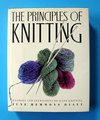 I’ve been in a bit of a knitting slump this week and busy with other things so there’s been no progress on my current project other than a bit of spinning so that I can finish the sleeves. Tomorrow I should be able to find time to continue.
I’ve been in a bit of a knitting slump this week and busy with other things so there’s been no progress on my current project other than a bit of spinning so that I can finish the sleeves. Tomorrow I should be able to find time to continue.
Since I don’t have anything to show I thought I’d mention a handy little book that I picked up a couple of months ago.
Like many knitters, I not only knit at home but also knit whenever I can find a spare moment, wherever I might be – particularly while traveling via car, plane or boat. One dilemma that I always face when preparing my knitting bag, is what reference book I should take. Most are not an option due to their bulky size, while others that are not so bulky don’t contain enough of the techniques that I tend to use.
When I first started flipping through this book, I didn’t expect much because I’m not a big fan of Knitter’s Magazine and haven’t purchased their magazine very often. While I always flip through each new issue, I’m usually disappointed with what they offer and tend to pass it up for Interweave Knits or Vogue Knitting. So with that being said, I was surprised to find that this book contains most of the information I would expect to need while knitting on the road. Now that I think about it, early issues of Knitter’s were filled with articles by Elizabeth Zimmerman, Priscilla Gibson-Roberts, Nancy Bush, and Deborah Newton to name a few. So, maybe it’s not so crazy to think that Knitter’s could come up with a good compact knitting reference.
So what do I like about it?
- The publisher has given permission to the readers to photocopy instructions and graphics for personal use
- Besides a table of contents, it also has an index
- It not only covers the basics but also mentions some, not so basic techniques, such as tubular bind-off and cast-on, long-tail cast-on, purl, invisible cast-on, crochet for finishing, grafting in several stitch patterns, lifted increases, short-rows for shoulders and the list goes on
- The spiral binding, durable cover and portable dimensions (8″ X 6.5)
So what would I change?
It would have been helpful if it had some yardage charts for basic sweaters, socks, hats & mittens. Also, the sweater sizing chart could have included sweater sizing for not only bust/chest, but also body length and hips. I’d also change the cover graphic.
I’m thrilled that the publisher has give permission to copy from the book because I plan to copy selected pages when I work on a project and add them to the small binder that I carry in my knitting bag. That way I’ll have less to haul around.
 Looking for a book with detailed instructions on how to design lace?
Looking for a book with detailed instructions on how to design lace?

 I’ve been in a bit of a knitting slump this week and busy with other things so there’s been no progress on my current project other than a bit of spinning so that I can finish the sleeves. Tomorrow I should be able to find time to continue.
I’ve been in a bit of a knitting slump this week and busy with other things so there’s been no progress on my current project other than a bit of spinning so that I can finish the sleeves. Tomorrow I should be able to find time to continue. Last night I went to
Last night I went to  I first saw a copy of this book while taking a class about spinning for socks with Judith McKenzie McCuin a couple of months ago. She mentioned that it is the best resource for information about fit for any knitted garment.
I first saw a copy of this book while taking a class about spinning for socks with Judith McKenzie McCuin a couple of months ago. She mentioned that it is the best resource for information about fit for any knitted garment. Last weekend I made a trip to Weaving Works to pick up a new smaller sized cable needle (the red thing in the picture) and came across Cable Needle Freedom by Carole Wulster. It promises to teach knitters how to knit without a cable needle. I was intrigued and on a whim purchased it along with the cable needle.
Last weekend I made a trip to Weaving Works to pick up a new smaller sized cable needle (the red thing in the picture) and came across Cable Needle Freedom by Carole Wulster. It promises to teach knitters how to knit without a cable needle. I was intrigued and on a whim purchased it along with the cable needle. For a few weeks now, I’ve been patiently waiting for Knitting on the Edge to show up at a local yarn shop or bookstore so I could flip through it to see if it’s a keeper. Last week my patient wore out and I ended up ordering a copy, sight unseen.
For a few weeks now, I’ve been patiently waiting for Knitting on the Edge to show up at a local yarn shop or bookstore so I could flip through it to see if it’s a keeper. Last week my patient wore out and I ended up ordering a copy, sight unseen.





